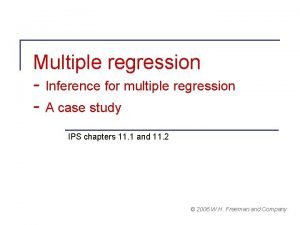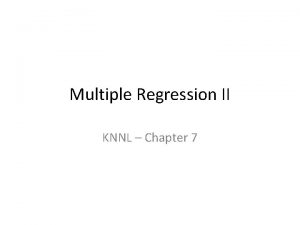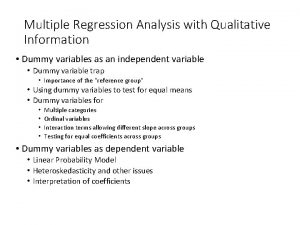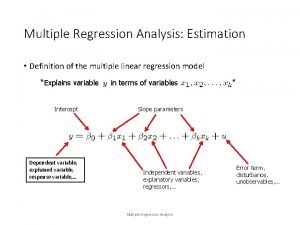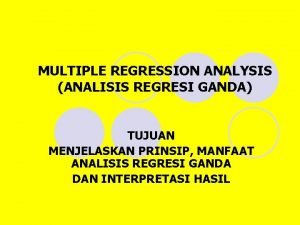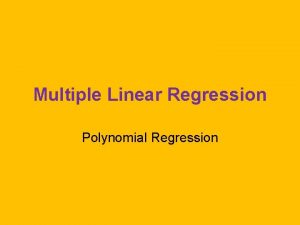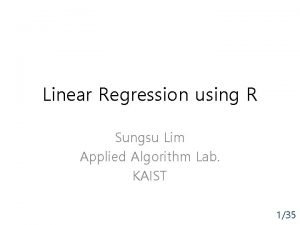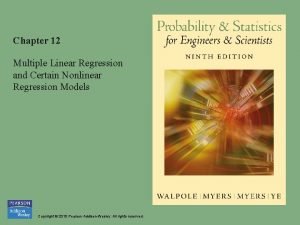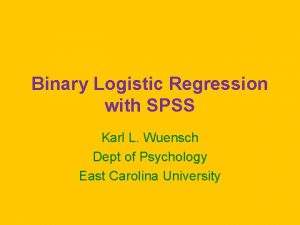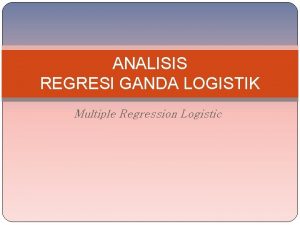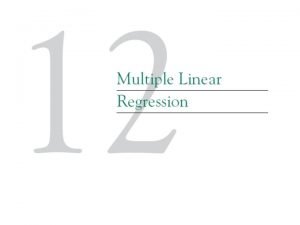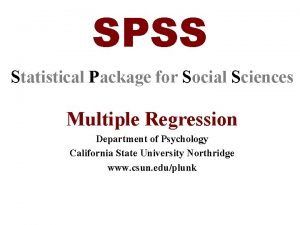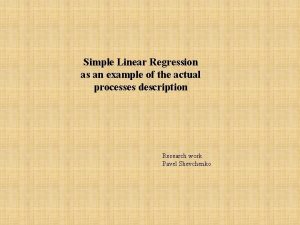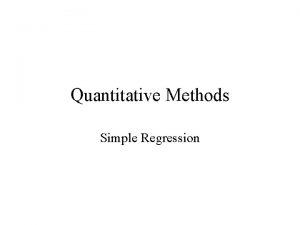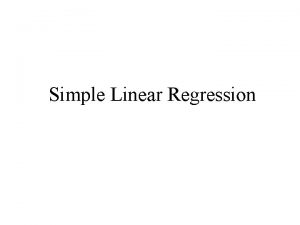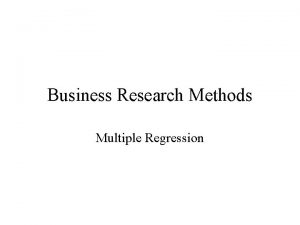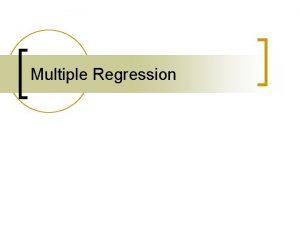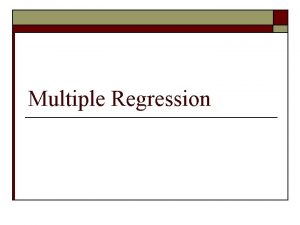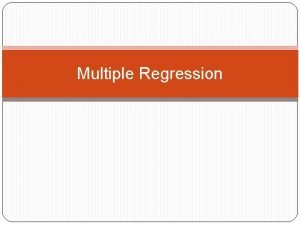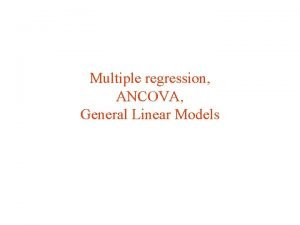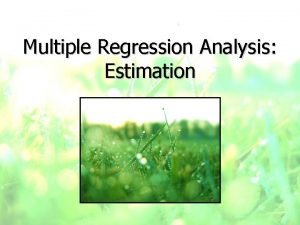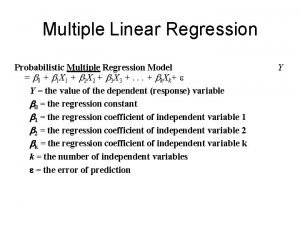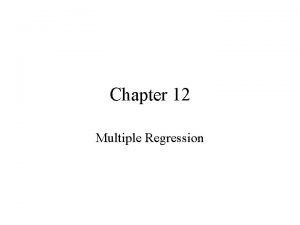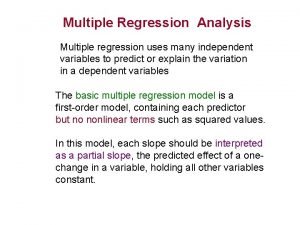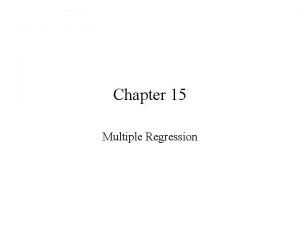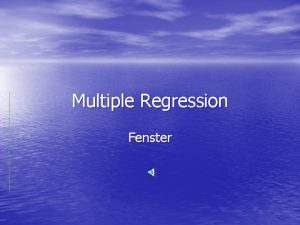Multiple Regression Simple Regression in detail Yi o





















- Slides: 21

Multiple Regression

Simple Regression in detail Yi = βo + β 1 xi + εi Where • Y =>Dependent variable • X =>Independent variable • βo =>Model parameter – Mean value of dependent variable (Y) when the independent variable (X) is zero

Simple Regression in detail • Β 1 => Model parameter - Slope that measures change in mean value of dependent variable associated with a oneunit increase in the independent variable • εi => - Error term that describes the effects on Yi of all factors other than value of Xi

Assumptions of the Regression Model • Error term is normally distributed (normality assumption) • Mean of error term is zero (E{εi} = 0) • Variance of error term is a constant and is independent of the values of X (constant variance assumption) • Error terms are independent of each other (independent assumption) • Values of the independent variable X is fixed – No error in X values.

Estimating the Model Parameters • Calculate point estimate bo and b 1 of unknown parameter βo and β 1 • Obtain random sample and use this information from sample to estimate βo and β 1 • Obtain a line of best "fit" for sample data points least squares line = bo + b 1 Xi Where is the predicted value of Y

Values of Least Squares Estimates bo and b 1 = n xiyi - ( xi)( yi) n xi 2 - ( xi)2 bo = y - bi x Where y = yi n ; x = xi n • bo and b 1 vary from sample to sample. Variation is given by their Standard Errors Sbo and Sb 1

Example 1 • To see relationship between Advertising and Store Traffic • Store Traffic is the dependent variable and Advertising is the independent variable • We find using the formulae that bo=148. 64 and b 1 =1. 54 • Are bo and b 1 significant? • What is Store Traffic when Advertising is 600?

Example 2 • Consider the following data Sales (X) Advertising(Y) 3 7 8 13 17 13 4 11 15 16 7 6 • Using formulae we find that b 0 = -2. 55 and b 1 = 1. 05

Example 2 Therefore the regression model would be Ŷ = -2. 55 + 1. 05 Xi r 2 = (0. 74)2 = 0. 54 (Variance in sales (Y) explained by ad (X)) Assume that the Sbo(Standard error of b 0) = 0. 51 and Sb 1 = 0. 26 at = 0. 5, df = 4, Is bo significant? Is b 1 significant?

Idea behind Estimation: Residuals • Difference between the actual and predicted values are called Residuals • Estimate of the error in the population ei = yi - yi = yi - (bo + b 1 xi) Quantities in hats are predicted quantities • bo and b 1 minimize the residual or error sums of squares (SSE) SSE = ei 2 = ( (yi - yi)2 = Σ [yi-(bo + b 1 xi)]2

Testing the Significance of the Independent Variables • Null Hypothesis • There is no linear relationship between the independent & dependent variables • Alternative Hypothesis • There is a linear relationship between the independent & dependent variables

Testing the Significance of the Independent Variables • Test Statistic t = b 1 - β 1 sb 1 • Degrees of Freedom v=n-2 • Testing for a Type II Error H 0: β 1 = 0 H 1: β 1 0 • Decision Rule Reject H 0: β 1 = 0 if α > p value

Significance Test for Store Traffic Example • Null hypothesis, Ho: β 1=0 • Alternative hypothesis, HA: β 1 0 • The test statistic is t = = =7. 33 • With as 0. 5 and with Degree of Freedom v = n-2 =18, the value of t from the table is 2. 10 • Since , we reject the null hypothesis of no linear relationship. Therefore Advertising affects Store Traffic

Predicting the Dependent Variable • How well does the model yi = bo + bixi predict? • Error of prediction without indep var is yi - yi • Error of prediction with indep var is yi- yi • Thus, by using indep var the error in prediction reduces by (yi – yi)-(yi- yi)= (yi – yi) • It can be shown that (yi - y)2 = ( yi - y)2 + (yi - yi)2

Predicting the Dependent Variable • Total variation (SST)= Explained variation (SSM) + Unexplained variation (SSE) • A measure of the model’s ability to predict is the Coefficient of Determination (r 2) r 2 = = • For our example, r 2 =0. 74, i. e, 74% of variation in Y is accounted for by X • r 2 is the square of the correlation between X and Y

Multiple Regression • Used when more than one indep variable affects dependent variable • General model Where Y: Dependent variable : Independent variables : Coefficients of the n indep variables : A constant (Intercept)

Issues in Multiple Regression • Which variables to include • Is relationship between dep variables and each of the indep variables linear? • Is dep variable normally distributed for all values of the indep variables? • Are each of the indep variables normally distributed (without regard to dep var) • Are there interaction variables? • Are indep variables themselves highly correlated?

Example 3 • Cataloger believes that age (AGE) and income (INCOME) can predict amount spent in last 6 months (DOLLSPENT) • The regression equation is DOLLSPENT = 351. 29 - 0. 65 INCOME +0. 86 AGE • What happens when income(age) increases? • Are the coefficients significant?

Example 4 • Which customers are most likely to buy? • Cataloger believes that ratio of total orders to total pieces mailed is good measure of purchase likelihood • Call this ratio RESP • Indep variables are - TOTDOLL: total purchase dollars - AVGORDR: average dollar order - LASTBUY: # of months since last purchase

Example 4 • Analysis of Variance table - How is total sum of squares split up? - How do you get the various Deg of Freedom? - How do you get/interpret R-square? - How do you interpret the F statistic? - What is the Adjusted R-square?

Example 4 • Parameter estimates table - What are the t-values corresp to the estimates? - What are the p-values corresp to the estimates? - Which variables are the most important? - What are standardized estimates? - What to do with non-significant variables?
 Simple multiple linear regression
Simple multiple linear regression Multiple regression vs simple regression
Multiple regression vs simple regression Major details
Major details Minor and major details
Minor and major details Logistic regression vs linear regression
Logistic regression vs linear regression Logistic regression vs linear regression
Logistic regression vs linear regression Linear trend equation
Linear trend equation Anova multiple regression
Anova multiple regression Extra sum of squares multiple regression
Extra sum of squares multiple regression Multiple regression analysis with qualitative information
Multiple regression analysis with qualitative information Define multiple regression analysis
Define multiple regression analysis Dataset for regression analysis
Dataset for regression analysis Multiple regression analysis adalah
Multiple regression analysis adalah Polynomial regression spss
Polynomial regression spss Linear regression multiple features
Linear regression multiple features Sum of squares
Sum of squares Multiple nonlinear regression spss
Multiple nonlinear regression spss Binary logistic regression spss
Binary logistic regression spss Pengertian regresi logistik
Pengertian regresi logistik Multiple linear regression variance
Multiple linear regression variance Hierarchical multiple regression spss
Hierarchical multiple regression spss Multiple linear regression analysis formula
Multiple linear regression analysis formula







